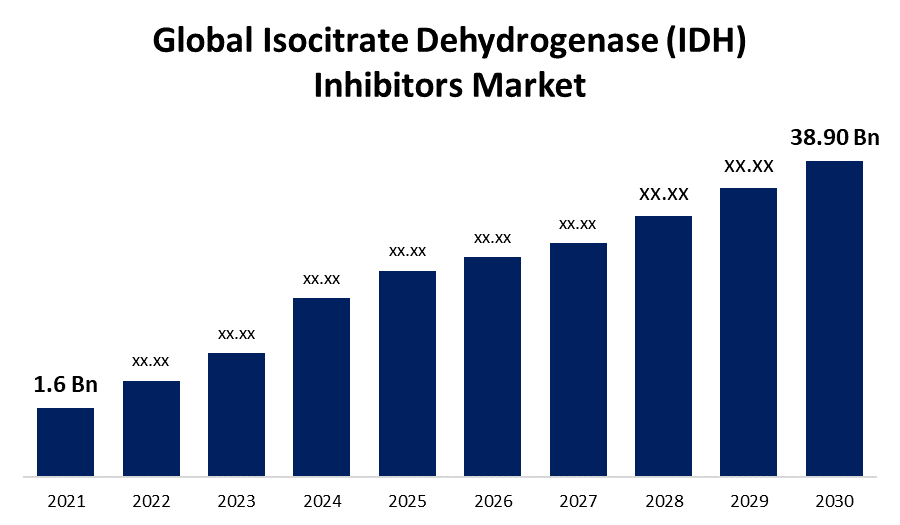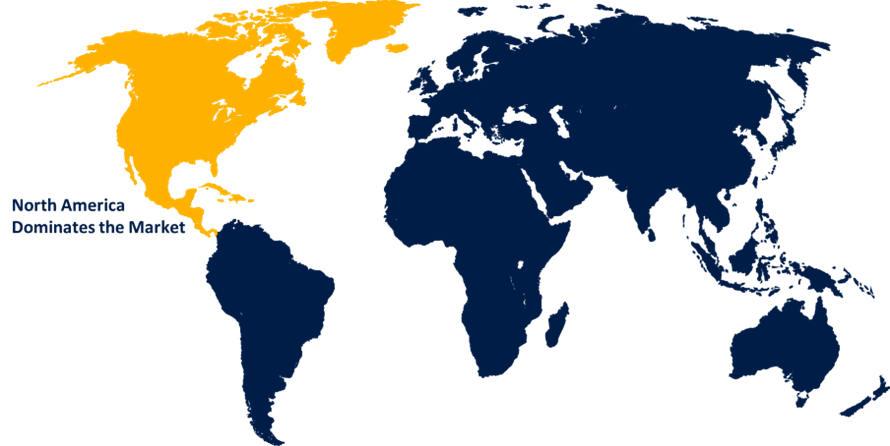Global Isocitrate Dehydrogenase (IDH) Inhibitors Market Size, Share, and COVID-19 Impact Analysis, By Type (IDH1 Mutant Medullary Malignant Tumor, IDH2 Mutant Medullary Malignant Tumor, Others), By Application (FLT3 Inhibitor, DH Inhibitor, Hedgehog Pathway Inhibitor, Others), and By Region (North America, Europe, Asia-Pacific, Latin America, Middle East, and Africa), Analysis and Forecast 2021 - 2030
Industry: HealthcareGlobal Isocitrate Dehydrogenase (IDH) Inhibitors Market Insights Forecasts to 2030
- The Global Isocitrate Dehydrogenase (IDH) Inhibitors Market Size was valued at USD 1.6 Billion in 2021
- The Market is Growing at a CAGR of 42.55% from 2021 to 2030
- The Worldwide Isocitrate Dehydrogenase (IDH) Inhibitors Market size is expected to reach USD 38.90 Billion by 2030
- Asia Pacific is expected To Grow the fastest during the forecast period

Get more details on this report -
The Global Isocitrate Dehydrogenase (IDH) Inhibitors Market Size is expected to reach USD 38.90 Billion by 2030, at a CAGR of 42.55% during the forecast period 2021-2030. According to the kinetic and structural studies, isocitrate dehydrogenase inhibitors are either capable of binding to the alpha-KG/Isocitrate site and as such act as binding competitors.
Market Overview
Isocitrate Dehydrogenase is an enzyme that get involve in the converting into isocitrate of tricarboxylic acid cycle to ketoglutarate. In a two-step reaction, IDH plays a crucial role in catalyzing the reversible conversion of isocitrate to alpha-ketoglutarate and CO2. They could also bind allosterically to the connection between two promoters of the isocitrate dehydrogenase enzyme dimer. Variations in the enzyme isocitrate dehydrogenase 1 (IDH1) start causing metabolic changes & the sustained formation of 2-hydroxyglutarate (2-HG). 2-HG is an oncometabolite because it inhibits the activity of α-ketoglutarate-dependent dioxygenases including ten-eleven translocation enzymes. IDH has a role in a variety of physiological functions, including mitochondrial oxidative phosphorylation, glutamine metabolism, lipogenesis, glucose sensing, and cellular redox state modulation. This protein is primarily involved in cellular energy metabolism and plays a vital function in tricarboxylic acid (TCA) cycle regulation in many tissues.
Report Coverage
This research report categorizes the global isocitrate dehydrogenase (IDH) inhibitors market based on various segments and regions and forecasts revenue growth and analyses trends in each submarket. The report analyses the key growth drivers, opportunities, and challenges influencing the global isocitrate dehydrogenase (IDH) inhibitors market. Recent market developments and competitive strategies such as expansion, product launch, and development, partnership, merger, and acquisition have been included to draw the competitive landscape in the market. The report strategically identifies and profiles the key market players and analyses their core competencies in each sub-segments of the global isocitrate dehydrogenase (IDH) inhibitors market.
Global Isocitrate Dehydrogenase (IDH) Inhibitors Market Report Coverage
| Report Coverage | Details |
|---|---|
| Base Year: | 2021 |
| Market Size in 2021: | USD 1.6 Billion |
| Forecast Period: | 2021-2030 |
| Forecast Period CAGR 2021-2030 : | 42.55% |
| 2030 Value Projection: | USD 38.90 Billion |
| Historical Data for: | 2017-2020 |
| No. of Pages: | 200 |
| Tables, Charts & Figures: | 100 |
| Segments covered: | By Type, By Application, By Region, COVID-19 Impact Analysis |
| Companies covered:: | Bayer, Agios Pharma, Celgene, Pfizer, Inc., Philogen S.p.A, Ohm Oncology, Tragara/Adastra, Aslan Pharmaceuticals, Daiichi Sankyo, Sun Pharmaceutical Industries Ltd. |
| Pitfalls & Challenges: | COVID-19 Empact, Challenge, Future, Growth, & Analysis |
Get more details on this report -
Driving Factors
The increase in the frequency of acute myeloid leukemia is driving market growth. Acute leukemia is the most common type of leukemia in adults, with over 20.450 cases diagnosed in the United States each year. Moreover, the rising geriatric population and unmet healthcare needs are driving market growth.
Restraining Factors
The adverse effects of dehydrogenase inhibitors such as vomiting, nausea, diarrhea, and decreased appetite, may restraints the market growth during the forecast period.
Market Segmentation
Global Isocitrate Dehydrogenase Inhibitors Market, By Type
Based on type, the global isocitrate dehydrogenase (IDH) inhibitors market is classified into IDH1 Mutant Medullary Malignant Tumor, IDH2 Mutant Medullary Malignant Tumors, and Others.
Global Isocitrate Dehydrogenase Inhibitors Market, By Application
Based on application, the global isocitrate dehydrogenase (IDH) inhibitors market is bifurcated into FLT3 inhibitors, DTH inhibitors, hedgehog pathway inhibitors & others.
Regional Segment Analysis of the global isocitrate dehydrogenase (IDH) inhibitors market
- North America (U.S., Canada, Mexico)
- Europe (Germany, France, U.K., Italy, Spain, Rest of Europe)
- Asia-Pacific (China, Japan, India, Rest of APAC)
- South America (Brazil and the Rest of South America)
- The Middle East and Africa (UAE, South Africa, Rest of MEA)
North America accounted largest market share over the forecast period

Get more details on this report -
North America is dominating the market of global isocitrate dehydrogenase inhibitors during the forecast period due to rising recent technological advancements. Moreover, the availability of numerous cutting-edge pharmacological molecules to improve the therapeutic process also dominates the market growth.
Asia Pacific is also expected to grow the market substantially during the forecast period owing to the increasing technologies and the rising healthcare expenditure in developing countries like China, and India. However, the rising population is also expected to witness the largest market growth during the forecast period.
Competitive Analysis:
The report offers the appropriate analysis of the key organizations/companies involved within the global isocitrate dehydrogenase (IDH) inhibitors market along with a comparative evaluation primarily based on their product offering, business overviews, geographic presence, enterprise strategies, segment market share, and SWOT analysis. The report also provides an elaborative analysis focusing on the current news and developments of the companies, which includes product development, innovations, joint ventures, partnerships, mergers & acquisitions, strategic alliances, and others. This allows for the evaluation of the overall competition within the market.
List of Key Companies
- Bayer
- Agios Pharma
- Celgene
- Pfizer, Inc.
- Philogen S.p.A
- Ohm Oncology
- Tragara/Adastra
- Aslan Pharmaceuticals
- Daiichi Sankyo
- Sun Pharmaceutical Industries Ltd.
Key Target Audience
- Market Players
- Investors
- End-users
- Government Authorities
- Consulting And Research Firm
- Venture capitalists
- Value-Added Resellers (VARs)
Recent Developments
- On May 2020, Agios Pharmaceuticals reported updated data from the ongoing Phase 1 study evaluating single-agent vorasidenib in isocitrate dehydrogenase (IDH)-mutant advanced solid tumors, including glioma. Through that, American Society of Clinical Oncology, data from the non-enhancing glioma population were presented in an oral presentation, which is being held virtually.
Market Segment
This study forecasts revenue at global, regional, and country levels from 2019 to 2030. Spherical Insights has segmented the global isocitrate dehydrogenase (IDH) inhibitors market based on the below-mentioned segments:
Global Isocitrate Dehydrogenase (IDH) Inhibitors market, By Type
- IDH1 Mutant Medullary Malignant Tumor
- IDH2 Mutant Medullary Malignant Tumor
- Others
Global Isocitrate Dehydrogenase (IDH) Inhibitors market, By Application
- FLT3 Inhibitor
- DH Inhibitor
- Hedgehog Pathway Inhibitor
- Others
Global Isocitrate Dehydrogenase (IDH) Inhibitors market, Regional Analysis
- North America
- US
- Canada
- Mexico
- Europe
- Germany
- U.K.
- France
- Italy
- Spain
- Russia
- Rest of Europe
- Asia Pacific
- China
- Japan
- India
- South Korea
- Australia
- Rest of Asia Pacific
- South America
- Brazil
- Argentina
- Rest of South America
- Middle East & Africa
- UAE
- Saudi Arabia
- Qatar
- South Africa
- Rest of Middle East & Africa
Need help to buy this report?